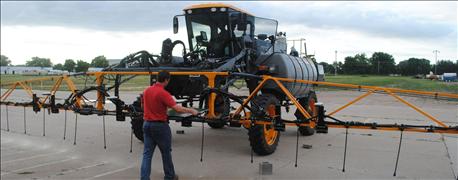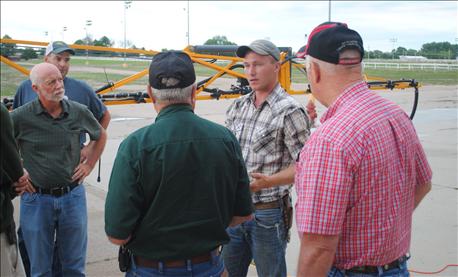
Learning by doing is something University of Nebraska Extension educators and researchers have been working on when it comes to nitrogen management. Nebraska producers and researchers are looking at ways to more effectively utilize nitrogen to reduce cost and chances at groundwater and surface water contamination and to reduce waste without giving up yield.

SENSOR DEMO: UNL Extension educator, Nathan Mueller, demonstrates how crop canopy sensors work by flashing different shaded green cards under the sensors during a Project SENSE demonstration day in Columbus this past summer.
UNL's Project SENSE – Sensors for Efficient Nitrogen Use and Stewardship of the Environment – addresses these challenges, implementing the program at around 20 on-farm research sites each year over three years. At a demonstration day held in Columbus last summer, UNL Dodge County Extension educator, Nathan Mueller, held different shaded green cards beneath crop canopy sensors mounted on a high-clearance machine to show how the sensors can read nitrogen needs of the plants by sensing the changes in color.
UNL Extension cropping systems and agriculture technologies educator, Laura Thompson says that the project is looking at two nitrogen management approaches. One approach is the grower's standard N management, which varies from person to person. The other is sensor-based in-season N management. "We compared the total N applied for these two approaches and found that collectively, over 17 sites tested this year, the sensor-based method resulted in around 25% less nitrogen being applied," Thompson says. At one site, the sensor method used 65 pounds less N and had no yield difference compared to the grower's management approach, she explains. "This translates into approximately $42 per acre savings in N fertilizer cost, assuming fertilizer cost of 65 cents per pound of N," she says.

APPLICATION DETAILS: UNL graduate student, John Parrish conducted the applications for Project SENSE in 2015. He visited with producers about the details of the treatments at the Columbus demonstration day.
Thompson admits that this won't be the case at every site, but it does exhibit the value of the sensor-based method to growers. "The goal of this project is to increase fertilizer N use efficiency through the use of in-season N fertilization," she says. This has been a challenge for producers in the past and the sensor-based method may offer a solution for micromanaging nutrients during the growing season.
"Ultimately, the objective is to increase farmer profitability and reduce negative environmental impacts," Thompson says. "Because crop canopy sensing is a reactive approach, the N rate can be adjusted based on weather conditions occurring in the early part of the growing season which can influence the amount of N fertilizer the crop needs," she says. "This technology also allows the N rate to be spatially adjusted throughout the field."
The technology for this approach continues to evolve. At the Columbus meeting, UNL Extension educators talked with producers about how the sensors work and how they communicate with the high-clearance machine to apply rapid treatment on the go in the field. Thompson says that the project is helping researchers learn more about equipment and data handling too. Final results of the first year of the project were released during a series of recent on-farm research network update meetings held across the state in February.
You can learn more by contacting Thompson at 402-624-8033 or email [email protected].
About the Author(s)
You May Also Like






